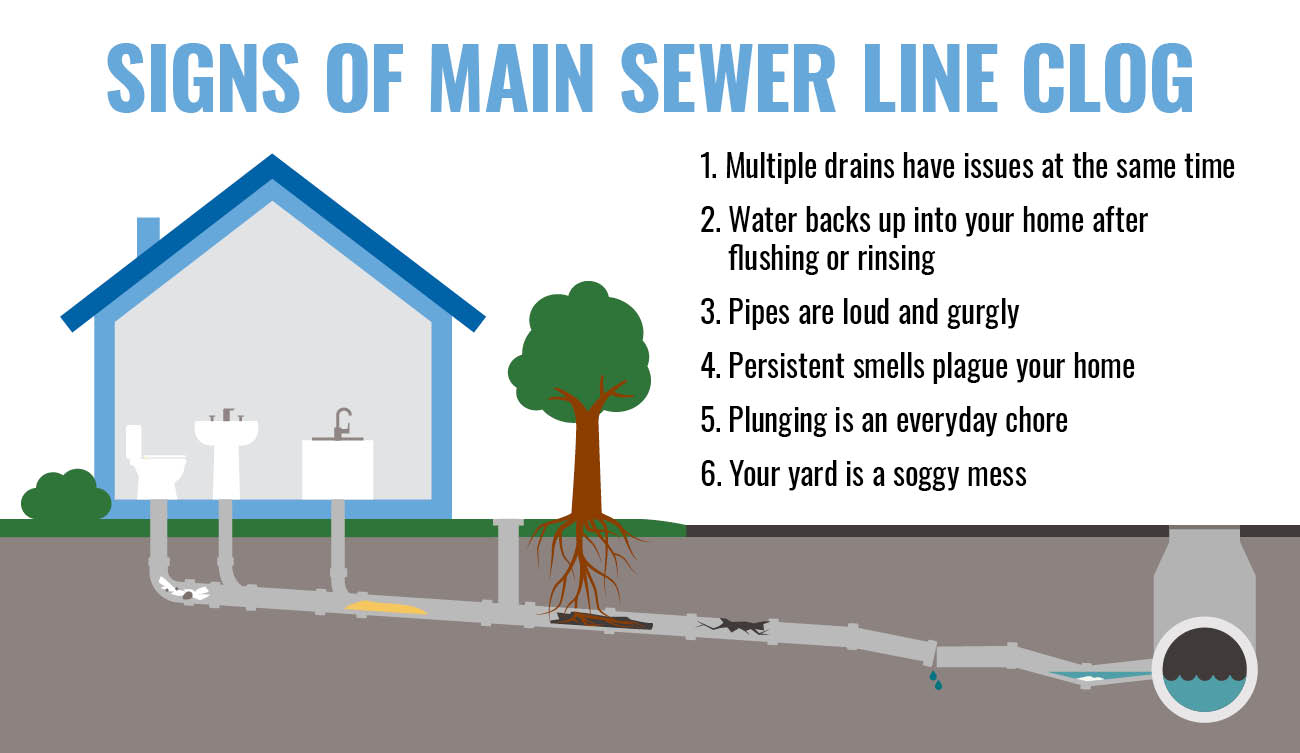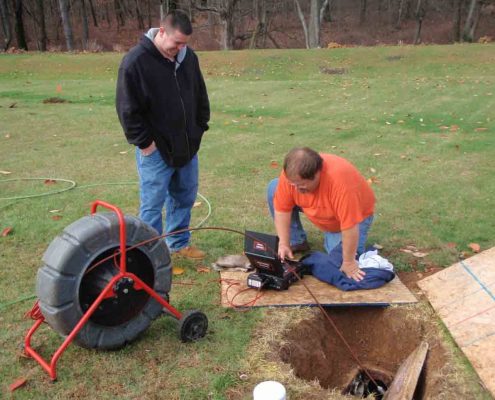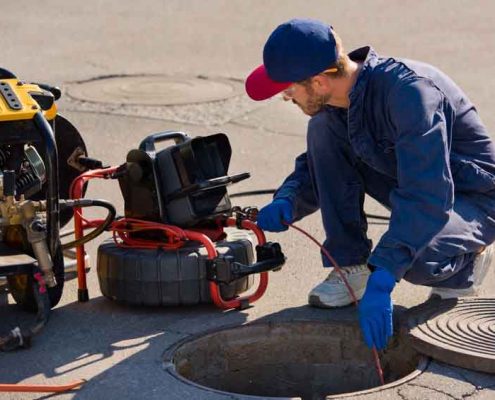How Do I Know My Home Sewer Line Is Clogged, and What Do I Do Next?
Pipes and plumbing are some of the most important fixtures in any home, but it’s easy to forget about the constant work your home sewer system is doing when everything is flowing smoothly behind the scenes. Many homes still rely on decades-old pipelines to carry wastewater from the home to the municipal sewer main. For some, this means it may only be a matter of time before a main sewer line clog occurs, especially if pipes have been misused or ill-maintained over the years.
Even if you avoid rinsing or flushing anything you aren’t supposed to down your drains, an aging, deteriorating sewer line is susceptible to damage from prolonged wear and tear. Whatever it is causing problems in your pipelines, you can prevent further damage by being aware of the signs and addressing the issue right away.
What is the difference between a clogged drain pipe and a clogged sewer line?
When a drain pipe is clogged, it only impacts the attached plumbing. Your home’s sewer pipe lateral, on the other hand, controls the flow of everything out of your home. If this main sewer line clogs, multiple fixtures back up because wastewater can’t leave your home.
All plumbing in your home connects to the sewer lateral, which is responsible for carrying wastewater from your home to the municipal sewer main operated by the city. While a clogged toilet or sink is typically remedied with a plunger or snake, multiple drain pipes clogged simultaneously indicate an issue in your home’s sewer lateral that needs professional attention. Remember everything you rinse down your sink or flush in the toilet travels through the sewer lateral en route to the municipal main. Even if it seems to drain or flush without issue initially, it can build up once it reaches your sewer lateral and have lasting ramifications for your entire home.
There are a few items you should be particularly cautious of that may seem safe for flushing or rinsing but actually are harmful to your pipes. Kitchen grease is a common culprit causing clogged sewer lines. Wipes claiming to be flushable can also wreak havoc on pipelines. Even if you aren’t flushing these other items, sewer mains are an attractive source of hydration for tree roots growing underground, so roots can invade your sewer lateral in a sneak attack you don’t see coming. You can’t always prevent every disaster. But you can avoid further damage by recognizing the warning signs of a main sewer line clog and addressing the issue quickly.
Signs of a Main Sewer Line Clog
You’ll likely notice right away when your plumbing isn’t working properly—an overflowing toilet or backed-up sink is hard to miss. The real question is: is it a problem with your main sewer line or is it localized to just one drain pipe? There are several critical signs of a main sewer line clog you can look out for, including:

1. Multiple Drains Have Issues At The Same Time
If the bathroom sink, kitchen sink, toilet and shower suddenly seem to have trouble draining, it’s not a coincidence. When multiple fixtures fail to flush or drain properly, it’s likely a clogged sewer line. One important note to consider: since the sewer lateral runs underground outside your home, plumbing in the basement or on the main floor of your home will back up first before eventually reaching upper levels. It may get progressively worse rather than occurring simultaneously across the home.
2. Water Backs Up Into Your Home After Flushing or Rinsing
Main sewer line clogs keep all the wastewater and debris from entering the municipal sewer main, which means the backed-up material has no other outlet than back through your pipes the way it came. When your sewer line is clogged, something as harmless as flushing the toilet could cause another fixture, like the bathtub or sink, to overflow. This is a clear sign the problem is not localized to just one pipe.
3. Pipes Are Loud and Gurgly
Your plumbing won’t be able to tell you what’s wrong with it, but that doesn’t mean you can’t listen. Gurgling noises after running water or flushing the toilet indicate your plumbing is in distress. The wastewater can’t pass through the clogged sewer line, so you’ll likely be able to hear when the plumbing isn’t flowing smoothly as expected.
4. Persistent Smells Plague Your Home
Lingering sewage odors throughout your house are a strong and highly unpleasant sign of a main sewer line clog. Without a clear path to the municipal sewer main, the backed-up sewage and wastewater remain stagnant, carrying scents through your home. Aside from creating a less comfortable living environment, clogged sewer lines can release potentially hazardous gas fumes and other toxins, endangering your family. When pipes start to smell and sound off, it’s time to hire a professional plumber to safely investigate the source of the issue.
5. Plunging Is An Everyday Chore
It’s normal for individual drains and pipes to get clogged or backed up every once in a while, but if you’re attempting to flush the toilet and have to reach for the plunger nearly every time, a main sewer line clog in your lateral may be the real problem. If problems persist, you should call a professional plumber right away to determine if a clogged sewer line is the culprit.
6. Your Yard Is A Soggy Mess
It’s important to seek help immediately when you suspect your home sewer line is clogged because ignoring the issue can escalate the damage. Blockages exert pressure within the pipe, which can cause the pipe to crack, leak or even collapse, flooding your yard with the wastewater inside. Don’t prolong calling a plumber—contact a local sewer repair and cleaning company you can trust to resolve any issues right away.
What to Do If Your Sewer Line Is Clogged
The most important thing to remember when managing a main sewer line clog is never to ignore the problem. Here’s how to handle problematic plumbing without panicking or worsening the issue:
1. Turn Water Off & Avoid Using Plumbing Fixtures
Temporarily shutting off your home’s water supply ensures the issue can’t be exasperated further if multiple drains and toilets are already backed up. It’s better to briefly be without plumbing while coordinating a solution with a plumbing contractor than to let the blockage build up and cause irreparable damage to your home’s sewer lateral. Catching a main sewer line clog early is your best bet to get the situation under control before it gets more destructive.
2. Contact A Professional Sewer & Plumbing Expert
Plumbing professionals have the experience, equipment and expertise needed to safely scope out the clogged sewer line via a sewer camera inspection. Your home’s sewer lateral is too important to risk harming its integrity with harsh, corrosive drain cleaners or non-professional tools not designed to navigate the intricacies of the sewer pipe. Professionals not only eliminate existing blockages, they can also suggest solutions that strengthen your pipes and prevent future blockages so your plumbing is more reliable for long-lasting use.

How Professionals Help to Clear Main Sewer Lines More Safely & Efficiently for Homeowners
Through a detailed sewer camera inspection, a plumber can fully assess your sewer line's condition, locate the clog's source and recommend solutions to restore your pipe if needed. When sewer lines are clogged, it’s often a sign of a larger issue within the pipe. Whether it’s invasive tree roots, misaligned joints, structural cracks or a corroded interior, your efforts to remove the blockage could just be a band-aid over a much bigger problem.
Home tools like drain snakes, augers and chemical solutions may work for individual drain pipes when clogged, but these items aren’t equipped to safely reach a main sewer line clog in the sewer lateral outside your home. Attempting to remedy a clogged sewer line using a snake or auger can simply push the blockage further out of reach within the lateral. Without the proper tools and training to navigate drain pipes and sewer laterals, you may cause further damage to your pipes by scraping them up or drilling into the wrong area. The same can be said about corrosive drain chemicals claiming to remove blockages—caustic substances wear down interior pipe surfaces, creating a host of future problems for your pipelines. Mistakes like these put your pipes at risk but could potentially endanger your family if harmful sewer gasses or chemicals leak into the air.
Meanwhile, sewer repair professionals are trained to quickly examine pipelines with state-of-the-art sewer camera inspection technology that pinpoints the location of problem areas. If the sewer line is clogged, technicians can follow up with sewer and drain cleaning services. Trenchless technology like hydro jetting is designed to blast blockages using a high-pressure water stream. No chemicals or digging are involved, ensuring your property remains intact.
If a professional determines a main sewer line clog is the result of a larger issue within your sewer lateral, they’ll have the resources and next steps to get to the root of the problem and fully restore your pipelines. Trenchless sewer line repair services effectively seal and rehabilitate deteriorating, cracked pipes with no digging required, strengthening your sewer lateral from within the existing pipe. Some of the main concerns homeowners have about outsourcing their plumbing revolve around potential damage to their property and disturbance to their utilities. However, when you work with the right sewer cleaning and repair professionals that have your best interests in mind, you’ll receive recommendations that are cost-effective, quick and minimally invasive to your property.
Questions to Ask Your Plumber if You Suspect a Clogged Sewer Line
To vet potential plumbers, consider your expectations for the services. Will they have a plan to identify the problem? Can they respond to your request in a timely fashion? By asking the right questions, you find the right solutions to combat a clogged sewer line effectively. Questions to ask your plumber include:
- Do you offer a free sewer camera inspection to help diagnose the issue?
- Do you respond to urgent requests promptly?
- How long does it typically take to resolve the issue?
- What materials and methods do you use for sewer cleaning and repair?
- Do you offer trenchless solutions to minimize property damage?
- Will there be extended downtime to my utilities?
- Do you offer financing options to cover sewer cleaning and repair costs?
CME Sewer Repair specializes in trenchless sewer line repair to help homeowners throughout Ohio, Indiana, Kentucky and Missouri resolve clogged sewer lines and sewer backups. We work quickly using our hydro jetting equipment and proven trenchless pipe lining techniques to eliminate blockages and restore sewer laterals. It’s free to get started with a sewer camera inspection!

CME Sewer Repair Offers Free Sewer Camera Inspections to Get You Started
CME Sewer Repair is ready to be your trusted provider for reliable home sewer cleaning and rehabilitation. We offer local financing solutions, enabling our customers to get help when needed and evaluate main sewer line clogs right away. Contact us to speak with us if you’re still uncertain whether your drain pipe is clogged or if the issue lies in the sewer lateral. Ready to get started? Contact CME for a free sewer camera inspection to check in on the condition of your pipelines today.
Schedule Your Free Inspection
To Access Exclusive Updates From CME Sewer Repair, Subscribe To Our Monthly Newsletter Below